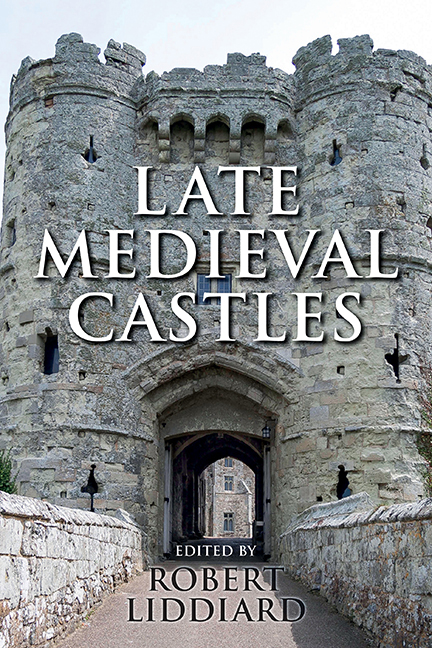Book contents
- Frontmatter
- Contents
- List of Illustrations
- Acknowledgements
- Editor's Preface
- List of Abbreviations
- A Note on the Text
- Introduction
- 1 Fourteenth-Century Castles in Context: Apotheosis or Decline?
- 2 Architects, Advisors and Design at Edward I's Castles in Wales
- 3 The Courtyard and the Tower: Contexts and Symbols in the Development of Late Medieval Great Houses
- 4 Castle Planning in the Fourteenth Century
- 5 Meaningful Constructions: Spatial and Functional Analysis of Medieval Buildings
- 6 Mota, Aula et Turris: The Manor-Houses of the Anglo-Scottish Border
- 7 Lulworth Castle, Dorset
- 8 A Scottish Problem with Castles
- 9 Structural Symbolism in Medieval Castle Architecture
- 10 Specimens of Freedom to Crenellate by Licence
- 11 Some Analysis of the Castle of Bodiam, East Sussex
- 12 English Castles in the Reign Of Edward II
- 13 Castles of Ward and the Changing Pattern of Border Conflict in Ireland
- 14 The Donjon Of Knaresborough: The Castle As Theatre
- 15 The Architecture of Arthurian Enthusiasm: Castle Symbolism in the Reigns of Edward I and his Successors
- 16 Medieval Ornamental Landscapes
- 17 Otherworld Castles in Middle English Arthurian Romance
- Guide to Further Reading
- Index
4 - Castle Planning in the Fourteenth Century
Published online by Cambridge University Press: 29 April 2017
- Frontmatter
- Contents
- List of Illustrations
- Acknowledgements
- Editor's Preface
- List of Abbreviations
- A Note on the Text
- Introduction
- 1 Fourteenth-Century Castles in Context: Apotheosis or Decline?
- 2 Architects, Advisors and Design at Edward I's Castles in Wales
- 3 The Courtyard and the Tower: Contexts and Symbols in the Development of Late Medieval Great Houses
- 4 Castle Planning in the Fourteenth Century
- 5 Meaningful Constructions: Spatial and Functional Analysis of Medieval Buildings
- 6 Mota, Aula et Turris: The Manor-Houses of the Anglo-Scottish Border
- 7 Lulworth Castle, Dorset
- 8 A Scottish Problem with Castles
- 9 Structural Symbolism in Medieval Castle Architecture
- 10 Specimens of Freedom to Crenellate by Licence
- 11 Some Analysis of the Castle of Bodiam, East Sussex
- 12 English Castles in the Reign Of Edward II
- 13 Castles of Ward and the Changing Pattern of Border Conflict in Ireland
- 14 The Donjon Of Knaresborough: The Castle As Theatre
- 15 The Architecture of Arthurian Enthusiasm: Castle Symbolism in the Reigns of Edward I and his Successors
- 16 Medieval Ornamental Landscapes
- 17 Otherworld Castles in Middle English Arthurian Romance
- Guide to Further Reading
- Index
Summary
The form and content of any building is the expression of its designer's brief, and that brief will, almost inevitably, contain conflicting elements. Overshadowing the development of the medieval castle as a building is the conflict between its military and its domestic functions. The form taken at any particular time is bound to be a compromise between these two issues, which will not only vary in relative importance but will each one vary as techniques in their respective fields develop. Although in this paper it is proposed to follow trends in domestic demands and observe their effect on the form of the castle, this aspect should not properly be treated in isolation, and if little mention is made of the military element it must be remembered that this is, nevertheless, always present. It is proposed to analyse three individual fourteenth-century buildings as a means of determining these trends, but before doing so the position reached in the previous century must be summarised, first as to what may be established as the basic requirements for a household in terms of plan form and secondly as to how this was used to provide the accommodation demanded in the greater castles, thereby demonstrating something of the approach of the designers of that time to this particular problem.
Through the thirteenth century two common house plan forms dominate, the upper or twin hall type and the end hall or hall and chamber-block type. The upper hall house, which tended to die out towards the end of the century, consists essentially of two identical floor plans, superimposed on each other, each containing a hall with an inner chamber attached at one end. It may appear in more elaborate form with additional chambers attached to both hall and inner chamber while still retaining its twin nature providing for two households. Of the two forms the hall and chamber-block plan is the more persistent. It was the basic form before the Conquest and, though temporarily swamped by the upper hall house, returned to increasing favour as the thirteenth century progressed. Its elements are a group or groups of chambers associated with a common hall. In its simplest form it appears as a ground-floor hall with a two-storey block of chambers at one end, providing for a single household.
- Type
- Chapter
- Information
- Late Medieval Castles , pp. 79 - 100Publisher: Boydell & BrewerPrint publication year: 2016



